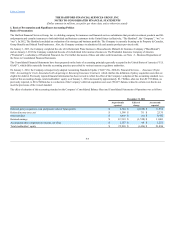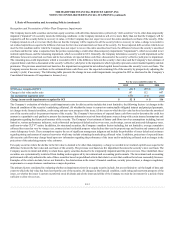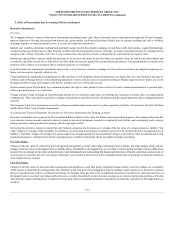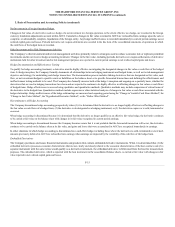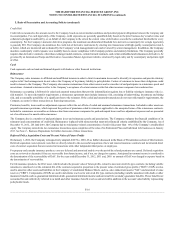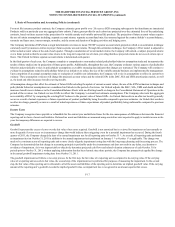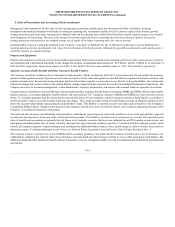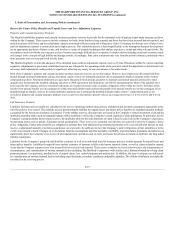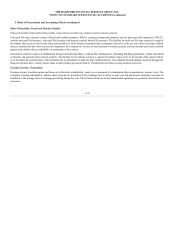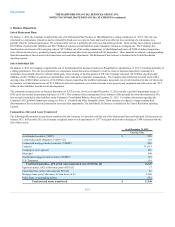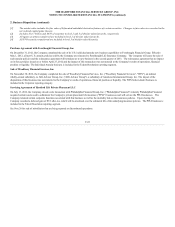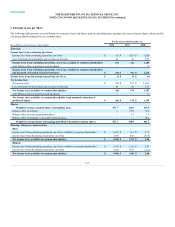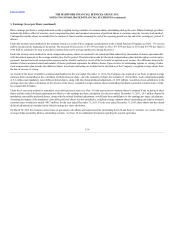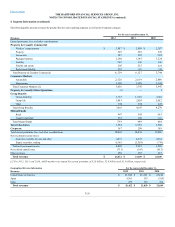The Hartford 2012 Annual Report Download - page 157
Download and view the complete annual report
Please find page 157 of the 2012 The Hartford annual report below. You can navigate through the pages in the report by either clicking on the pages listed below, or by using the keyword search tool below to find specific information within the annual report.
Credit Risk
Credit risk is measured as the amount owed to the Company based on current market conditions and potential payment obligations between the Company and
its counterparties. For each legal entity of the Company, credit exposures are generally quantified daily based on the prior business day’s market value and
collateral is pledged to and held by, or on behalf of, the Company to the extent the current value of derivatives exceeds the contractual thresholds for every
counterparty. For the Company’s domestic derivative programs, the maximum uncollateralized threshold for a derivative counterparty for a single legal entity
is generally $10. The Company also minimizes the credit risk of derivative instruments by entering into transactions with high quality counterparties rated A
or better, which are monitored and evaluated by the Company’s risk management team and reviewed by senior management. In addition, the Company
monitors counterparty credit exposure on a monthly basis to ensure compliance with Company policies and statutory limitations. The Company generally
requires that derivative contracts, other than exchange traded contracts, certain forward contracts, and certain embedded and reinsurance derivatives, be
governed by an International Swaps and Derivatives Association Master Agreement which is structured by legal entity and by counterparty and permits right
of offset.
Cash
Cash represents cash on hand and demand deposits with banks or other financial institutions.
Reinsurance
The Company cedes insurance to affiliated and unaffiliated insurers in order to limit its maximum losses and to diversify its exposures and provide statutory
surplus relief. Such arrangements do not relieve the Company of its primary liability to policyholders. Failure of reinsurers to honor their obligations could
result in losses to the Company. The Company also assumes reinsurance from other insurers and is a member of and participates in reinsurance pools and
associations. Assumed reinsurance refers to the Company’s acceptance of certain insurance risks that other insurance companies have underwritten.
Reinsurance accounting is followed for ceded and assumed transactions that provide indemnification against loss or liability relating to insurance risk (i.e.
risk transfer). To meet risk transfer requirements, a reinsurance agreement must include insurance risk, consisting of underwriting, investment, and timing
risk, and a reasonable possibility of a significant loss to the reinsurer. If the ceded and assumed transactions do not meet risk transfer requirements, the
Company accounts for these transactions as financing transactions.
Premiums, benefits, losses and loss adjustment expenses reflect the net effects of ceded and assumed reinsurance transactions. Included in other assets are
prepaid reinsurance premiums, which represent the portion of premiums ceded to reinsurers applicable to the unexpired terms of the reinsurance contracts.
Included in reinsurance recoverables are balances due from reinsurance companies for paid and unpaid losses and loss adjustment expenses and are presented
net of an allowance for uncollectible reinsurance.
The Company also is a member of and participates in several reinsurance pools and associations. The Company evaluates the financial condition of its
reinsurers and concentrations of credit risk. Reinsurance is placed with reinsurers that meet strict financial criteria established by the Company. As of
December 31, 2012, 2011and 2010, the Company had no reinsurance-related concentrations of credit risk greater than 10% of the Company’s stockholders’
equity. The Company entered into two reinsurance transactions upon completion of the sales of its Retirement Plans and Individual Life businesses in January
2013. See Note 2 - Business Dispositions for further discussion of these transactions.
Deferred Policy Acquisition Costs and Present Value of Future Profits
On January 1, 2012, the Company retrospectively adopted ASU No. 2010-26 as further discussed in the Basis of Presentation section of this footnote.
Deferred acquisition costs represent costs that are directly related to the successful acquisition of new and renewal insurance contracts and incremental direct
costs of contract acquisition that are incurred in transactions with either independent third parties or employees.
For property and casualty insurance products, costs are deferred and amortized ratably over the period the related premiums are earned. Deferred acquisition
costs are reviewed to determine if they are recoverable from future income, and if not, are charged to expense. Anticipated investment income is considered in
the determination of the recoverability of DAC. For the years ended December 31, 2012, 2011 and, 2010 no amount of DAC was charged to expense based on
the determination of recoverability.
For life insurance products, the DAC asset, which includes the present value of future profits, related to most universal life-type contracts (including variable
annuities) is amortized over the estimated life of the contracts acquired in proportion to the present value of estimated gross profits (“EGPs”). EGPs are also
used to amortize other assets and liabilities in the Company’s Consolidated Balance Sheets, such as, sales inducement assets (“SIA”) and unearned revenue
reserves (“URR”). Components of EGPs are used to determine reserves for universal life type contracts (including variable annuities) with death or other
insurance benefits such as guaranteed minimum death, guaranteed minimum income and universal life secondary guarantee benefits. These benefits are
accounted for and collectively referred to as death and other insurance benefit reserves and are held in addition to the account value liability representing
policyholder funds.
F-16




